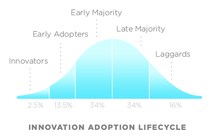
The technology adoption lifecycle is a sociological model that describes the adoption or acceptance of a new product or innovation, according to the demographic and psychological characteristics of defined adopter groups. The process of adoption over time is typically illustrated as a classical normal distribution or "bell curve". The model calls the first group of people to use a new product "innovators", followed by "early adopters". Next come the "early majority" and "late majority", and the last group to eventually adopt a product are called "laggards" or "phobics". For example, a phobic may only use a cloud service when it is the only remaining method of performing a required task, but the phobic may not have an in-depth technical knowledge of how to use the service.
The demographic and psychological (or "psychographic") profiles of each adoption group were originally specified by agricultural researchers in 1956:[1]
- innovators – had larger farms, were more educated, more prosperous and more risk-oriented
- early adopters – younger, more educated, tended to be community leaders, less prosperous
- early majority – more conservative but open to new ideas, active in community and influence to neighbors
- late majority – older, less educated, fairly conservative and less socially active
- laggards – very conservative, had small farms and capital, oldest and least educated
The model has subsequently been adapted for many areas of technology adoption in the late 20th century, for example in the spread of policy innovations among U.S. states. [2]